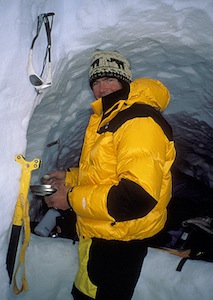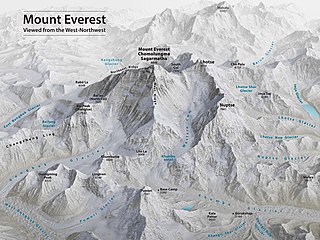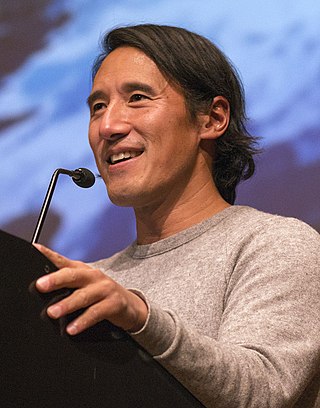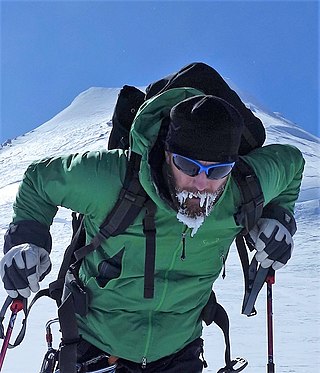Related Research Articles

Mount Everest is Earth's highest mountain above sea level, located in the Mahalangur Himal sub-range of the Himalayas. The China–Nepal border runs across its summit point. Its elevation of 8,848.86 m was most recently established in 2020 by the Chinese and Nepali authorities.

Lhotse is the fourth highest mountain in the world at 8,516 metres (27,940 ft), after Mount Everest, K2, and Kangchenjunga. The main summit is on the border between Tibet Autonomous Region of China and the Khumbu region of Nepal.

Shishapangma, or Shishasbangma (Xixabangma), also called Gosainthān, is the 14th-highest mountain in the world, at 8,027 metres (26,335 ft) above sea level. It is located entirely within China. In 1964, it became the final eight-thousander to be climbed.

The Kangshung Face or East Face is the eastern-facing side of Mount Everest, one of the Tibetan sides of the mountain. It is 3,350 metres (11,000 ft) from its base on the Kangshung Glacier to the summit. It is a broad face, topped on the right by the upper Northeast Ridge, and on the left by the Southeast Ridge and the South Col. Most of the upper part of the face is composed of hanging glaciers, while the lower part consists of steep rock buttresses with couloirs between them. The steep southern third of the Kangshung Face also comprises the Northeastern Face of Lhotse; this section may be considered a separate face altogether following the division of the South "Neverest" Buttress up to the South Col. It is considered to be a dangerous route of ascent, compared to the standard North Col and South Col routes, and it is the most remote face of the mountain, with a longer approach.

Stewart Alexander Lowe was an American mountaineer. He has been described as inspiring "...a whole generation of climbers and explorers with his uncontainable enthusiasm, legendary training routines, and significant ascents of rock climbs, ice climbs, and mountains all over the world...". He died in an avalanche on Shishapangma, in Tibet. The Alex Lowe Charitable Foundation honors his legacy.
Marco Siffredi was a French snowboarder and mountaineer who hailed from a climbing family; his father was a mountain guide, and his older brother Pierre had died in an avalanche in their hometown of Chamonix, France. Siffredi was the first to descend Mount Everest on a snowboard, completing this feat in 2001 via the Norton Couloir. In 2002, he disappeared after making his second Everest summit, while attempting to snowboard the Hornbein Couloir; his body has never been found.

Mount Everest is the world's highest mountain, with a peak at 8,849 metres (29,031.7 ft) above sea level. It is situated in the Himalayan range of Solukhumbu district, Nepal.

Jimmy Chin is an American professional mountain athlete, photographer, skier, film director, and author.

Tomas Kenneth Olsson was a Swedish adventurer and ski mountaineer. He was born in Kristinehamn but grew up in Borås. He took an engineering degree at Linköping University in 2001, after which he moved to Chamonix in France to focus on skiing. He specialized in skiing down some of the world's highest and steepest mountains. He had gone from the top of Aconcagua in Argentina, Lenin Peak in Kyrgyzstan, Muztagh Ata and Kuksay Peak in China and Cho Oyu in Tibet.

The 1924 British Mount Everest expedition was—after the 1922 British Mount Everest expedition—the 2nd expedition with the goal of achieving the first ascent of Mount Everest. After two summit attempts in which Edward Norton set a world altitude record of 8,572.8 metres (28,126 ft), the mountaineers George Mallory and Andrew "Sandy" Irvine disappeared on the third attempt. Their disappearance has given rise to the long-standing speculation of whether or not the pair might – under a narrow set of assumptions – have reached the summit. Mallory's body was found in 1999 at 8,156 metres (26,760 ft), but the resulting clues did not provide any conclusive evidence as to whether the summit was reached.

The 1922 British Mount Everest expedition was the first mountaineering expedition with the express aim of making the first ascent of Mount Everest. This was also the first expedition that attempted to climb Everest using bottled oxygen. The expedition attempted to climb Everest from the northern side out of Tibet. At the time, Everest could not be attempted from the south out of Nepal as the country was closed to Western foreigners.
James N. Hooper is a British mountain climber and adventurer who in 2006 became one of the youngest Britons to climb Mount Everest, along with his friend Rob Gauntlett.

Andrzej Leszek Bargiel is a Polish ski mountaineer, backcountry skier, mountain runner and climber. Raised in Łętownia, he is a three-time Polish ski mountaineering champion and held third place in the overall World Cup. He is the current record holder in taking the least amount of time to achieve the Snow Leopard award. He is also the current record holder in the Elbrus Race. Since 2013, he has been running his original HIC SUNT LEONES project, the goal of which are speedy, oxygenless ascents and ski descents from the highest mountain peaks on Earth. These included Shishapangma in 2013, Manaslu in 2014, Broad Peak in 2015, and K2 in 2018. He lives in Zakopane, Poland.

Ueli Steck was a Swiss rock climber and alpinist. He was the first to climb Annapurna solo via its South Face, and set speed records on the North Face trilogy in the Alps. He won two Piolet d'Or awards, in 2009 and 2014. Having previously summitted Mount Everest, Steck died on 30 April 2017 after falling during an acclimatizing climb for an attempt on the Hornbein route on the West Ridge of Everest without supplemental oxygen.

The Norton Couloir or Great Couloir is a steep gully high on the north face of Mount Everest in Tibet which lies east of the pyramidal peak and extends to within 150 m below the summit.

Olof Sundstrom is a Swedish adventurer, high altitude mountaineer, solo sailor and inspirational speaker.

Hilaree Nelson was an American ski mountaineer. She became the first woman to summit two 8000-meter peaks in one 24-hour push on May 25, 2012. On September 30, 2018, Nelson and partner Jim Morrison made the first ski descent of the "Dream Line", the Lhotse Couloir from the summit. Lhotse is the 4th-highest mountain in the world and shares a saddle with Mount Everest.

The 1979 Yugoslav Mount Everest expedition was the first successful summit of Mount Everest (8,848m) using the entire West Ridge route in the North Face of Everest. It was the seventh expedition in the Himalayas by the Yugoslav alpinist team, and their first ascent to the highest peak of Mount Everest. The route became known as the "Yugoslavian route" after the first successful ascent. The Yugoslav state leadership declared this ascent the greatest achievement of Yugoslav sports up to that time.
References
- ↑ Bradley Mayhew; Robert Kelly; John Vincent Bellezza (2008). Tibet . Lonely Planet. p. 209. ISBN 9781741045697 . Retrieved 29 July 2010.
Tormod Granheim.
- ↑ Kodas, Michael (2008). High Crimes: The Fate of Everest in an Age of Greed. Hyperion. p. 312. ISBN 978-1-4013-0273-3 . Retrieved 29 July 2010.
- ↑ "Tormods egne ord om ulykken". 18 May 2006.
- ↑ Brevik, Christian (6 September 2006). "Reddet fra synkende sivbåt". Budstikka (in Norwegian). Retrieved 29 July 2010.
- ↑ Hartwig, Kathinka (29 November 2016). "Han er kåret til årets eventyrer". DN (in Norwegian). Retrieved 17 February 2017.